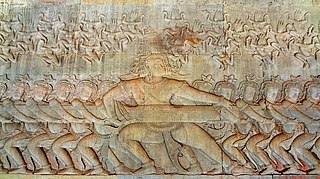
Asuras are a class of beings in Indic religions. They are described as power-seeking clans related to the more benevolent Devas in Hinduism. In its Buddhist context, the word is sometimes translated "titan", "demigod", or "antigod".

Krishna Dvaipayana, better known as Vyasa or Vedavyasa, is a central and revered sage portrayed in most Hindu traditions. He is traditionally regarded as the author of the Mahabharata. He is also regarded by many Hindus as the compiler of a number of significant scriptures. As a partial incarnation, Amsa Avatar (aṃśa-avatāra) of Vishnu, he is also regarded by tradition as the compiler of the mantras of the Vedas into four Vedas, as well as the author of the eighteen Puranas and the Brahma Sutras. He is one of the seven Chiranjeevis.
Shruti in Sanskrit means "that which is heard" and refers to the body of most authoritative, ancient religious texts comprising the central canon of Hinduism. Manusmriti states: Śrutistu vedo vijñeyaḥ meaning, "Know that Vedas are Śruti". Thus, it includes the four Vedas including its four types of embedded texts—the Samhitas, the Upanishads, the Brahmanas and the Aranyakas.

The Brahmanas are Vedic śruti works attached to the Samhitas of the Rig, Sama, Yajur, and Atharva Vedas. They are a secondary layer or classification of Sanskrit texts embedded within each Veda, which explain and instruct on the performance of Vedic rituals. In addition to explaining the symbolism and meaning of the Samhitas, Brahmana literature also expounds scientific knowledge of the Vedic Period, including observational astronomy and, particularly in relation to altar construction, geometry. Divergent in nature, some Brahmanas also contain mystical and philosophical material that constitutes Aranyakas and Upanishads.
Saṃhitā literally means "put together, joined, union", a "collection", and "a methodically, rule-based combination of text or verses". Saṃhitā also refers to the most ancient layer of text in the Vedas, consisting of mantras, hymns, prayers, litanies and benedictions.
The Atharva Veda is the "knowledge storehouse of atharvāṇas, the procedures for everyday life". The text is the fourth Veda, and is a late addition to the Vedic scriptures of Hinduism.

The Yajurveda is the Veda primarily of prose mantras for worship rituals. An ancient Vedic Sanskrit text, it is a compilation of ritual-offering formulas that were said by a priest while an individual performed ritual actions such as those before the yajna fire. Yajurveda is one of the four Vedas, and one of the scriptures of Hinduism. The exact century of Yajurveda's composition is unknown, and estimated by Witzel to be between 1200 and 800 BCE, contemporaneous with Samaveda and Atharvaveda.

The Vedas are a large body of religious texts originating in ancient India. Composed in Vedic Sanskrit, the texts constitute the oldest layer of Sanskrit literature and the oldest scriptures of Hinduism.

The Limoniinae are a paraphyletic assemblage of genera within the crane flies, Tipulidae, although they can usually be distinguished by the way the wings are held at rest. Limoniines usually hold/fold the wings along the back of the body, whereas other tipulids usually hold them out at right angles. Snow flies such as Chionea scita have no wings at all. Limoniines are also usually smaller than other tipulids, with some exceptions. Limoniinae are a very large assemblage with nearly 10,500 described species in 133 genera, and were historically treated as a subfamily, but their classification is in flux; numerous authors recently treated the group at the rank of family, but subsequent phylogenetic analyses revealed that the remaining groups of tipulids render the group paraphyletic. These flies are found in damp places throughout the world, and many species form dense swarms in suitable habitats.
Ācāra is a concept used in the context of Classical Hindu law that refers to the customary laws or community norms of a particular social group. These community norms are delineated and put into practice by people who have earned the respect of those within each individual group, such as a community leader or elder. Although in Dharmaśāstra the ideal person who defines the ācāra of a particular place is dictated as one who knows the Vedas or is “learned”, in actual practice this role is often deferred to group leaders along with Vedic scholars. Ācāra is theologically important in Hindu law because it is considered, along with the Vedas (Śruti), and Smriti, to be one of the sources of dharma. Particular regional ācāra is believed to be canonized in Dharmaśāstra texts; however scholars differ on the source for the actual accounts found within these texts.
D. intermedia may refer to:
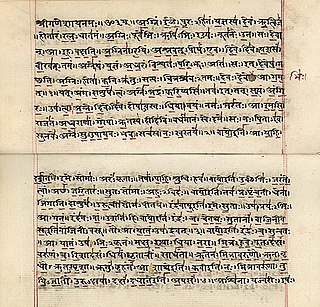
The Rigveda or Rig Veda is an ancient Indian collection of Vedic Sanskrit hymns (sūktas). It is one of the four sacred canonical Hindu texts (śruti) known as the Vedas.

The Samaveda, is the Veda of melodies and chants. It is an ancient Vedic Sanskrit text, and part of the scriptures of Hinduism. One of the four Vedas, it is a liturgical text which consists of 1,875 verses. All but 75 verses have been taken from the Rigveda. Three recensions of the Samaveda have survived, and variant manuscripts of the Veda have been found in various parts of India.
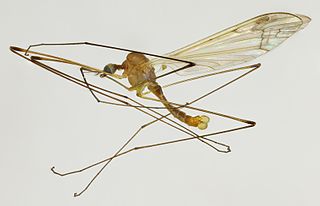
Dicranomyia chorea is a Palearctic species of cranefly in the family Limoniidae. It is found in a wide range of habitats and micro habitats: in earth rich in humus, in swamps and marshes, in leaf litter and in wet spots in woods.
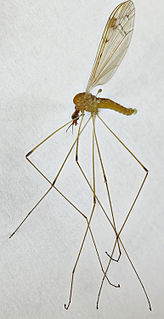
Dicranomyia didyma is a species of fly in the family Limoniidae. It is found in the Palearctic.

Dicranomyia fusca is a species of fly in the family Limoniidae. It is found in the Palearctic.
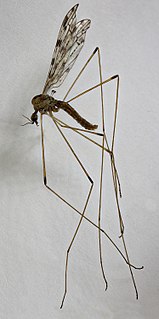
Dicranomyia goritiensis is a species of fly in the family Limoniidae. It is found in the Palearctic.

Dicranomyia modesta is a species of fly in the family Limoniidae. It is found in the Palearctic.












